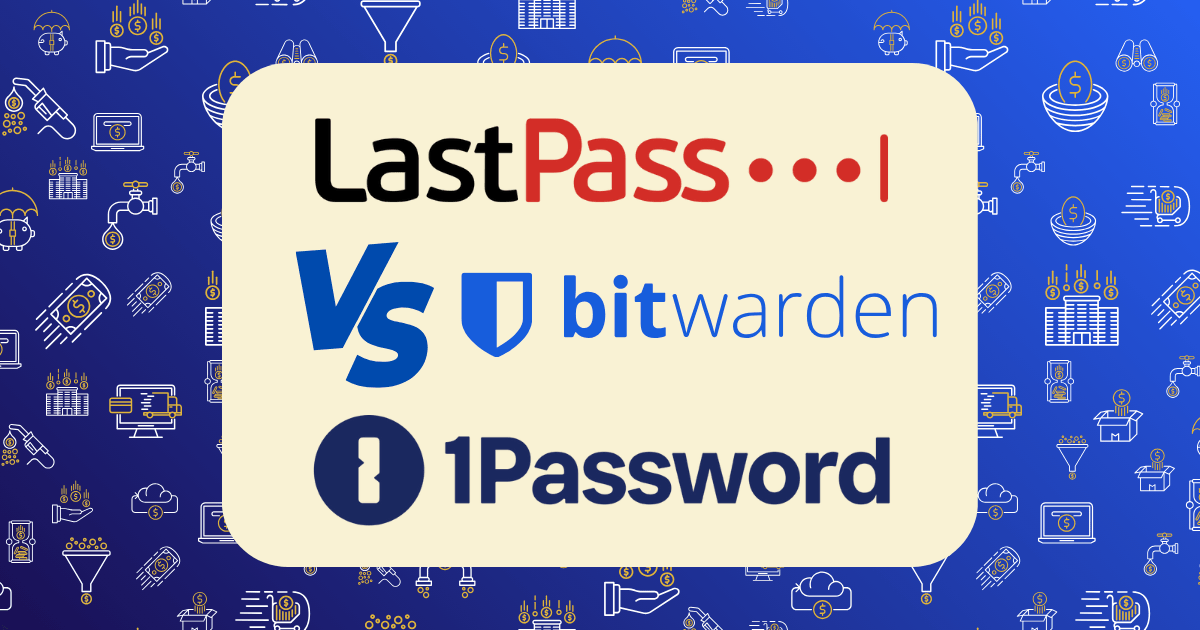LastPass vs 1Password vs Bitwarden: Password Managers for Business Security

In the wealth-building journey, protecting your digital assets is just as crucial as growing them. Yet many entrepreneurs overlook one of the most vulnerable aspects of their business security: password management. The average business employee manages 191 passwords across various platforms—each representing a potential entry point for threats that could devastate your business overnight.
I’ve consulted with dozens of entrepreneurs who discovered—often too late—that weak password practices were undermining their growth strategies. The solution isn’t complex, but it requires intentional implementation of the right tools.
Today, we’re comparing three leading password management solutions—LastPass, 1Password, and Bitwarden—to help you make an informed decision that aligns with your business security needs and wealth-building objectives.
The Hidden Cost of Poor Password Security
Before diving into comparisons, let’s address the financial implications of inadequate password management:
- The average data breach costs businesses $4.45 million, with small businesses often facing existential threats from such incidents
- 81% of hacking-related breaches leverage stolen or weak passwords
- Productivity losses from password resets and lockouts cost the average employee 12.6 hours annually
- Client trust—perhaps your most valuable asset—can evaporate instantly following a preventable security incident
A robust password management solution isn’t merely a security tool; it’s a business continuity investment that protects your wealth-building potential.
Key Evaluation Criteria
When assessing password managers for business use, five factors should guide your decision:
- Security architecture (encryption methods, breach history)
- Business-specific features (team management, access controls)
- Cross-platform compatibility (device support, browser extensions)
- User experience (adoption barriers, productivity impact)
- Total cost of ownership (subscription fees, implementation costs)
Let’s examine how our three contenders perform across these dimensions.
LastPass: The Familiar Name with a Complex History
LastPass remains one of the most recognized names in password management, with a substantial business user base despite recent security challenges.
Security Architecture
- Encryption: AES 256-bit encryption with PBKDF2 SHA-256
- Zero-knowledge design: Your master password never leaves your device
- Security history: Multiple breaches reported since 2022, including a significant incident where encrypted password vaults were compromised
- Audit status: SOC 2 Type 2 compliant
Business Features
- Admin dashboard: Comprehensive visibility into security practices
- Directory integration: Syncs with Active Directory and Azure AD
- Policies: 100+ configurable security policies
- Emergency access: Designated recovery contacts for business continuity
- Reporting: Detailed security reports and compliance documentation
Platform Compatibility
- Operating systems: Windows, macOS, Linux, iOS, Android
- Browsers: Chrome, Firefox, Safari, Edge, Opera
- Limitations: Free plan restricted to one device type (mobile or desktop)
User Experience
LastPass offers a straightforward onboarding process with guided tutorials for new users. The interface prioritizes simplicity, making it accessible for team members with varying technical proficiency. Auto-fill functionality works reliably across most platforms, though some users report occasional inconsistencies with complex web forms.
Pricing (2025)
- Teams: $4/user/month (up to 50 users)
- Business: $6/user/month
- Enterprise: $9/user/month
- Free trial: 14days
According to PCMag’s review, “LastPass remains a user-friendly option for businesses, though recent security incidents have raised legitimate concerns about its long-term reliability as an enterprise solution.”
1Password: Premium Experience with Business Focus
1Password has steadily gained market share in the business segment by offering a polished user experience backed by robust security practices.
Security Architecture
- Encryption: AES 256-bit encryption with PBKDF2
- Secret Key: Unique to 1Password, this adds an additional layer beyond the master password
- Security history: No known breaches to date
- Audit status: SOC 2 Type 2 compliant with regular third-party audits
Business Features
- Vaults: Segmented storage for different departments or projects
- Activity logs: Comprehensive audit trails of password access
- Travel Mode: Temporarily removes sensitive data when crossing borders
- Custom roles: Granular permission settings for different team members
- Directory sync: Integration with major identity providers
Platform Compatibility
- Operating systems: Windows (10+), macOS (10.15+), Linux, iOS (15.5+), Android (9+), Chrome OS
- Browsers: Chrome, Firefox, Safari, Edge, Brave
- Limitations: No free tier available, only trial access
User Experience
1Password excels in user experience with an intuitive interface that makes complex security practices accessible. The browser extensions are particularly well-designed, offering seamless auto-fill and generation capabilities. The initial setup requires more steps than competitors due to the Secret Key implementation, but this trade-off enhances security.
Pricing (2025)
- Teams: $19.95/month (flat fee for up to 10 users)
- Business: $7.99/user/month
- Enterprise: Custom pricing
- Free trial: 14 days
The Harvard Business Review notes that “1Password’s approach to business password management reflects a deep understanding of both security requirements and human behavior—a critical balance for sustainable security practices.”
Bitwarden: Open-Source Security with Budget Appeal
Bitwarden has disrupted the password management market with its open-source approach and competitive pricing, attracting security-conscious businesses operating with budget constraints.
Security Architecture
- Encryption: AES 256-bit encryption with PBKDF2
- Open-source code: Transparent security practices with community oversight
- Security history: No known breaches to date
- Audit status: Regular third-party audits with published results
Business Features
- Collections: Organization-wide password grouping
- Directory sync: Azure AD and other directory service integration
- Event logs: Detailed access and change tracking
- API access: Enterprise integration capabilities
- Self-hosting option: Complete control over infrastructure (unique to Bitwarden)
Platform Compatibility
- Operating systems: Windows (8+), macOS (10.14+), Linux, iOS (10+), Android (8+)
- Browsers: Chrome, Firefox, Safari, Edge, Opera, Vivaldi, Brave, Tor Browser
- Limitations: User interface less polished than premium alternatives
User Experience
Bitwarden prioritizes functionality over aesthetics, resulting in an interface that’s straightforward but less refined than 1Password or LastPass. The core password management features work reliably, though some advanced functions require more technical understanding. The self-hosting option appeals to organizations with specific compliance requirements or infrastructure preferences.
Pricing (2025)
- Free: Basic functionality for unlimited passwords
- Premium: $10/year for individual advanced features
- Families: $40/year for up to 6 users
- Teams: $3/user/month
- Enterprise: $5/user/month
- Free trial: Available for all paid plans
According to CyberInsider, “Bitwarden’s open-source approach provides transparency that security-conscious organizations value, particularly those with the technical resources to evaluate code quality themselves.”
Feature-by-Feature Comparison
| Feature | LastPass | 1Password | Bitwarden |
| Security Architecture | |||
| Encryption | AES 256-bit | AES 256-bit | AES 256-bit |
| Additional Security | PBKDF2 SHA-256 | Secret Key + PBKDF2 | PBKDF2 |
| Breach History | Multiple incidents | None reported | None reported |
| Open Source | No | No | Yes |
| Business Features | |||
| Admin Dashboard | Comprehensive | Comprehensive | Basic |
| User Roles | Advanced | Advanced | Basic |
| Directory Integration | Extensive | Extensive | Limited |
| Self-hosting Option | No | No | Yes |
| Usability | |||
| UI Polish | High | Very High | Moderate |
| Browser Extensions | All major browsers | All major browsers | Most browsers + Tor |
| Password Sharing | Team-based | Vault-based | Collection-based |
| Pricing | |||
| Starting Business Price | $4/user/month | $19.95/month (up to 10) | $3/user/month |
| Free Plan | Limited to 1 device | None | Yes, with core features |
| Storage | 1GB | 1GB (personal), 5GB (business) | 1GB (personal), 2GB (business) |
Implementation Strategy for Entrepreneurs
Selecting the right password manager is only the first step. To maximize security benefits while minimizing business disruption, follow this implementation framework:
Phase 1: Preparation (1-2 Weeks)
- Audit current practices: Document existing password management approaches
- Identify critical accounts: Prioritize financial, client, and operational systems
- Develop policies: Create clear guidelines for password complexity and sharing
- Select champions: Identify tech-savvy team members to support the rollout
Phase 2: Pilot Deployment (2-3 Weeks)
- Start with IT team: Deploy to technical staff who can troubleshoot issues
- Import existing passwords: Transfer from browsers and spreadsheets
- Test integrations: Verify compatibility with critical business systems
- Refine training materials: Develop custom guides based on pilot feedback
Phase 3: Full Implementation (1-2 Months)
- Phased rollout: Deploy by department to manage support requirements
- Mandatory training: Conduct sessions on proper usage and security practices
- Legacy cleanup: Systematically update and strengthen existing passwords
- Verification: Audit implementation success with reporting tools
Phase 4: Ongoing Management
- Regular audits: Monthly review of password health and sharing practices
- New employee onboarding: Incorporate password management into training
- Quarterly reviews: Assess security reports and address emerging vulnerabilities
- Annual reassessment: Evaluate if current solution still meets business needs
Making the Decision: Which Manager Fits Your Business?
Each solution offers distinct advantages depending on your business priorities:
Choose LastPass if:
- Your team requires minimal training and familiar interfaces
- Integration with existing business systems is a priority
- Comprehensive reporting for compliance is essential
- You’re comfortable with the security trade-offs given past incidents
Choose 1Password if:
- User experience and adoption rates are primary concerns
- Your business handles particularly sensitive information
- Travel security features would benefit your mobile workforce
- Budget constraints are secondary to security and usability
Choose Bitwarden if:
- Cost-effectiveness is a significant factor in your decision
- Your organization values open-source transparency
- You have technical resources to maximize self-hosting benefits
- Basic password management features meet your current needs
Beyond Technology: Building a Security Mindset
The most sophisticated password manager can’t protect a business where security isn’t valued culturally. As you implement your chosen solution, focus equally on developing these organizational habits:
- Regular security training: Schedule quarterly refreshers on emerging threats
- Recognition programs: Reward team members who identify and report security concerns
- Incident response planning: Develop clear protocols for potential breaches
- Executive modeling: Leadership must visibly adhere to security practices
Conclusion: Security as a Wealth-Protection Strategy
Password management isn’t merely an IT concern—it’s a fundamental business protection strategy. The right solution creates a foundation for sustainable growth by safeguarding your most valuable digital assets against increasingly sophisticated threats.
Whether you choose LastPass for its familiarity, 1Password for its premium experience, or Bitwarden for its cost-effective approach, implementing any structured password management system puts you ahead of 76% of businesses still relying on insecure practices.
Remember: In the digital economy, security isn’t just about preventing loss—it’s about creating the stable foundation necessary for confident expansion and wealth building.
Have you implemented a password manager in your business? Share your experience in the comments below.







